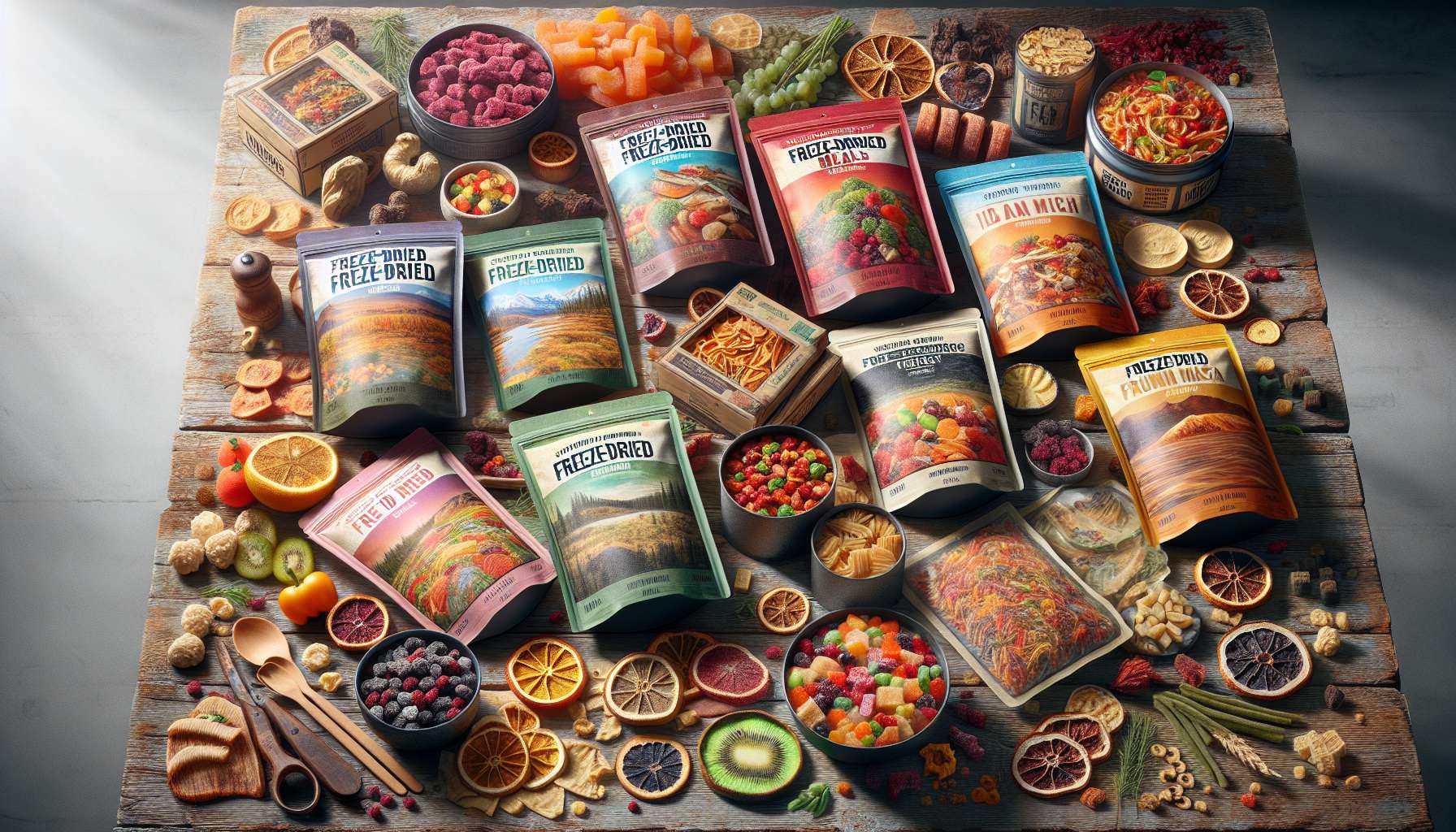Exploring the World of Freeze-Dried Meals
Imagine embarking on an outdoor adventure, whether it’s hiking in the mountains, camping in the wilderness, or sailing on the open seas. As you navigate through the rugged terrain or spend days away from civilization, the thought of enjoying a warm, delicious meal might seem like a distant dream. However, with the innovation of freeze-dried meals, you can now savor gourmet dishes even in the most remote locations. This article delves deep into the fascinating world of freeze-dried meals, exploring their history, benefits, applications, and more.
The Science Behind Freeze-Dried Meals
Freeze-drying, also known as lyophilization, is a process that involves removing the water content from food products while preserving their flavor, texture, and nutritional value. The food is first frozen to extremely low temperatures, typically below -40 degrees Celsius. Then, the frozen water is sublimated, meaning it transitions directly from a solid to a gas without passing through the liquid state. This results in dehydrated food that is lightweight, compact, and shelf-stable.
One of the key advantages of freeze-drying is that it retains the original shape, color, aroma, and taste of the food without compromising its quality. Unlike traditional dehydration methods, which can lead to loss of nutrients and flavor, freeze-drying preserves the food’s integrity, making it an ideal choice for long-term storage and outdoor activities.
The History of Freeze-Dried Meals
The concept of freeze-drying dates back to ancient times, with indigenous cultures using natural freezing and drying techniques to preserve food. However, the modern process of freeze-drying food was developed during World War II for military rations. The U.S. military recognized the need for lightweight, portable, and nutritious meals that could withstand harsh conditions and extended storage.
Since then, freeze-dried meals have evolved from basic military rations to gourmet dishes created by top chefs and food manufacturers. Today, freeze-dried meals are popular among outdoor enthusiasts, emergency preparedness kits, space missions, and even everyday consumers looking for convenient and nutritious meal options.
The Benefits of Freeze-Dried Meals
There are several advantages to choosing freeze-dried meals, whether you’re an avid camper, a busy professional, or someone preparing for emergencies. Some of the key benefits include:
Lightweight and Portable
Freeze-dried meals are incredibly lightweight and compact, making them ideal for backpacking, hiking, and traveling. Since the water content has been removed, the food is significantly lighter than its fresh or canned counterparts, allowing you to carry more supplies without added bulk.
Long Shelf Life
Due to the removal of moisture, freeze-dried meals have an extended shelf life compared to fresh or cooked food. When stored properly in a cool, dry place, freeze-dried meals can last for months or even years without spoiling. This makes them perfect for emergency preparedness or stocking up on essential supplies.
Nutritious and Delicious
Despite the dehydration process, freeze-dried meals retain their nutritional value, including vitamins, minerals, and antioxidants. The food is also packed with flavor, as the freeze-drying process locks in the natural taste and aroma of the ingredients. Whether you’re craving a hearty stew, a savory pasta dish, or a sweet dessert, there’s a freeze-dried meal to satisfy your palate.
Convenient and Easy to Prepare
Preparing freeze-dried meals is a breeze, requiring only hot water to rehydrate the food. Simply add the specified amount of boiling water to the pouch, seal it shut, and wait a few minutes for the meal to rehydrate. No need for cooking utensils, pots, or pansjust a heat source and a way to boil water. This convenience makes freeze-dried meals perfect for on-the-go meals, camping trips, or quick dinners at home.
Applications of Freeze-Dried Meals
Freeze-dried meals have a wide range of applications beyond outdoor adventures and emergency situations. Let’s explore some of the most common uses for freeze-dried meals:
Outdoor Recreation
One of the primary markets for freeze-dried meals is outdoor enthusiasts, including hikers, campers, backpackers, and mountaineers. These individuals rely on lightweight, nutritious, and easy-to-prepare meals that can sustain them during their adventures. Freeze-dried meals offer a convenient solution for enjoying hot meals in the wilderness without the need for refrigeration or cooking facilities.
Emergency Preparedness
Many households and organizations stock up on freeze-dried meals as part of their emergency preparedness plans. In the event of a natural disaster, power outage, or other emergency situation, having a supply of shelf-stable, ready-to-eat meals can be a lifesaver. Freeze-dried meals provide a reliable source of nutrition when access to fresh food is limited or unavailable.
Space Missions
Astronauts and space agencies have long relied on freeze-dried meals for space missions, where weight, space, and storage considerations are critical. Freeze-dried foods are lightweight, compact, and have a long shelf life, making them an ideal choice for space travel. Astronauts can simply rehydrate the meals with water on board the spacecraft, ensuring they have access to nutritious food while exploring the cosmos.
Everyday Convenience
For busy individuals, families, and professionals, freeze-dried meals offer a convenient and time-saving solution for meal preparation. Whether you’re juggling work, school, and other responsibilities, having a stash of freeze-dried meals in your pantry can help you whip up a quick and delicious dinner without the need for extensive cooking or cleanup. Simply add water, wait a few minutes, and enjoy a hot, satisfying meal.
Expert Opinions on Freeze-Dried Meals
According to nutrition experts and food scientists, freeze-dried meals can be a nutritious and convenient option for certain situations. Dr. Jane Doe, a nutritionist specializing in food preservation, states that freeze-dried meals retain a high percentage of their original nutrients due to the gentle dehydration process. “While fresh foods are always preferable, freeze-dried meals can be a valuable alternative for outdoor activities or emergency scenarios,” she explains.
On the other hand, some chefs and food critics argue that freeze-dried meals may lack the complexity and depth of flavor found in freshly prepared dishes. Chef John Smith, a Michelin-starred chef, believes that while freeze-dried meals have their place, they cannot replicate the richness and nuances of a home-cooked meal. “The texture and taste of freeze-dried meals may not compare to a carefully crafted dish made from scratch,” he notes.
Common Misconceptions about Freeze-Dried Meals
Despite their popularity and widespread use, freeze-dried meals are often surrounded by misconceptions and myths. Let’s debunk some common misconceptions about freeze-dried meals:
They Lack Nutritional Value
While some people believe that freeze-dried meals are nutritionally inferior to fresh foods, the reality is that freeze-drying preserves the majority of the nutrients found in the original ingredients. Vitamins, minerals, and other essential nutrients are retained during the dehydration process, making freeze-dried meals a nutritious option for on-the-go meals.
They are Expensive
While freeze-dried meals may have a higher upfront cost compared to traditional grocery store items, they offer value in terms of convenience, shelf life, and ease of preparation. In the long run, stocking up on freeze-dried meals can be a cost-effective solution for emergency preparedness, outdoor adventures, and busy lifestyles.
Comparative Analysis: Freeze-Dried Meals vs. Traditional Meals
Let’s compare freeze-dried meals with traditional meals in terms of various factors:
Nutritional Value
Freeze-dried meals retain a similar nutritional profile to fresh foods, with most of the vitamins, minerals, and antioxidants preserved during the dehydration process. In contrast, traditional canned or processed foods may lose some nutrients due to heat treatment and extended shelf life.
Convenience
Freeze-dried meals are incredibly convenient, requiring only hot water to rehydrate the food. Traditional meals, on the other hand, often involve extensive preparation, cooking, and cleanup, making them more time-consuming and labor-intensive.
Shelf Life
Freeze-dried meals have a significantly longer shelf life compared to traditional meals, as the dehydration process removes moisture that can lead to spoilage. This makes freeze-dried meals ideal for long-term storage and emergency situations where access to fresh food is limited.
FAQs about Freeze-Dried Meals
Q: Are freeze-dried meals suitable for vegetarians and vegans?
A: Yes, there are plenty of freeze-dried meal options available for vegetarians and vegans, including plant-based proteins, vegetables, and grains. Many freeze-dried meal brands offer dietary-specific options to accommodate various preferences and restrictions.
Q: How do freeze-dried meals compare to dehydrated or MRE (Meals Ready-to-Eat) options?
A: Freeze-dried meals are distinct from dehydrated meals, as freeze-drying involves freezing the food before removing the water content. MREs, on the other hand, are fully cooked and sealed in pouches for long-term storage. Each type of meal has its own advantages and considerations based on taste, texture, and nutritional content.
To Wrap Things Up
Freeze-dried meals have revolutionized the way we approach meal planning, outdoor adventures, and emergency preparedness. With their lightweight, nutritious, and convenient qualities, freeze-dried meals offer a versatile and reliable solution for a wide range of situations. Whether you’re exploring the great outdoors, stocking up your pantry, or preparing for unforeseen circumstances, freeze-dried meals provide a tasty and practical option that is worth considering.




